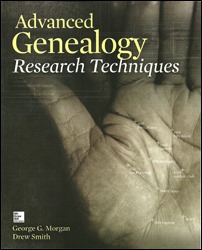 Title: Advanced Genealogy Research Techniques
Title: Advanced Genealogy Research Techniques
Authors: George G. Morgan and Drew Smith
Format: Paperback, Kindle, Nook
Published: 2013
Synopsis: (from book cover) Learn how to use innovative methods to unearth hard-to-find ancestors. Advanced Genealogy Research Techniques shows you, step by step, how to uncover elusive details by taking advantage of specialized tools and software programs and using proven best practices for breaking through the brick walls that have hindered your progress.
My Rating: ![]()
![]()
![]()
![]()
A fantastic book for anyone looking for creative ways to break through those pesky brick walls. Morgan and Smith use a physical brick wall analogy throughout the book to help illustrate their points about overcoming various issues in genealogy research. Real-life research examples further drive the points home in a practical manner.
My favorite quote on is on page 177, “There is no sharp dividing line between a beginning genealogist and an intermediate or advanced genealogist, and in reality, you may be a beginner in some areas or research and a more expert researcher in other areas.” This is so true, and is the very reason I would recommend this book to anyone interested in genealogy research, no matter your skill level.
Even if most of the techniques discussed in this book are part of your repertoire, it pays to see what others recommend and how they use the techniques to solve problems. There are so many effective ways to conduct genealogy research and the more perspectives you can gain will go a long way to help you solve even the most difficult research problems. And that is what this book does: provides the authors’ perspective on various techniques. While most of the techniques were not new to me, I walked away with an additional perspective, which will only make me a better researcher. In some cases, the authors’ perspective actually made me rethink what I knew and refocus my research, which has already paid off.
Chapter 3, “Go Around the Wall,” is a great explanation of cluster genealogy (or the FAN principle). This is one of those techniques that is often overlooked because it typically takes the focus away from direct line ancestors, or the family altogether, which many genealogists do not want to do. However, it is such an important aspect of genealogy research and in many cases, can solve the mysteries of those direct line ancestors we so desperately want answers to. Morgan and Smith do a great job illustrating why such research is important and give four wonderful examples of successful outcomes.
Those of you who are interested in putting the internet to work for you will appreciate Chapter 5, “Use Crowdsourcing.” Morgan and Smith spend much of this chapter discussing ways to use the internet as a collaborative research tool, from blogging to genealogy message boards to popular social media sites.
If you are looking for differing perspectives on tried-and-true and new-age genealogy research techniques to enhance your understanding and give you a better shot at busting your brick walls, I really do advise you to give this book a read. Like NBC says, “The more you know.”
Purchase Advanced Genealogy Research Techniques on Amazon: Paperback or Kindle

Share your thoughts...